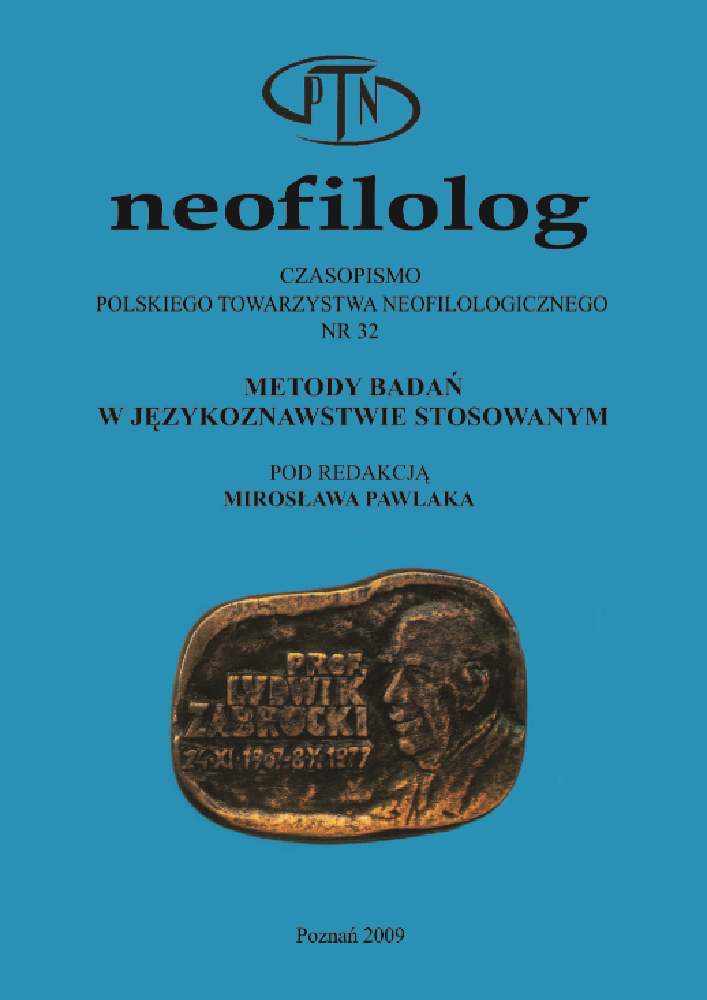Abstrakt
In studies on second language acquisition in formal settings, techniques characteristic of both qualitative and quantitative research paradigms are applied. In the first part of the article, we present general reflection on the methodology of studies on second language acquisition, with a particular emphasis on the role of exploratory research in the analysis of the process of second language teaching/learning in formal settings. In the second part, we present the concept of task, stressing its usefulness as a basic unit of analysis of the corpus of linguistic data obtained in the classroom.
Bibliografia
Allwright, R. L. 1983. „Classroom-centered research on language teaching and learning: A brief historical overview”. TESOL Quarterly 17. 191-204.
Chaudron, C. 1986. „The interaction of quantitative and qualitative approaches to research: A view of the second language classroom”. TESOL Quarterly 20. 709-717.
Chaudron, C. i Valcárcel, M. 1988. A process-product study of communicative language teaching (Final report submitted to the Comite Conjunto Hispano-Norteamericano para la Cooperación Cultural y Educativa, Madrid). Murcia, Espagne: Universidad de Murcia, Escuela Universitaria de Magisterio.
Cook, T. D. i Reichardt, C. S. (red.). 1979. Qualitative and quantitative methods in evaluation research. Beverly Hills, CA: Sage.
Dausendschőn-Gay, U., Gűlich, E. i Kraft, E. (red.). 1991. Linguistische Interaktionsanalysen. Tűbingen: Niemeyer.
Doughty, C. J. i Pica, T. 1985. „Input and interaction in the communicative language classroom: A comparison of teacher-fronted and group activities”, w: Gass, S. i Madden, C. (red.). 1985. 115-135.
Doughty, C. J. i Pica, T. 1986. „Information-gap tasks: Do they facilitate second language acquisition?”. TESOL Quarterly 20. 305-325.
Ellis, R. 1990. Instructed second language acquisition. Oxford. Blackwell.
Fotos, S. i Ellis, R. 1991. „Communicating about grammar: A task-based approach”. TESOL Quarterly 25. 605-628.
Gaonac’h, D. (red.). 1990. Acquisition et utilisation d’une langue étrangère. L’approche cognitive. Paris: Hachette.
Gass, S. i Madden, C. (red.). 1985. Input in second language acquisition. Rowely, MA, Newbury House.
Germain, C. 1999. „Structure fondamentale de l’enseignement d’une langue étrangère ou seconde”. Etudes de linguistique appliquée 114. 171-187.
Grassi, R. 2007. Parlare all’allievo straniero. Strategie di adattamento linguistico nella classe plurilingue. Perugia: Guerra Edizioni.
Gűlich, E. 1991. „Pour une ethnométhodologie linguistique: description de séquences conversationnelles explicatives”, w: Dausendschőn-Gay, U., Gűlich, E. i Kraft, E. (red.). 1991. 325-364.
Huberman, A. M. i Miles, M. B. 1991. Analyse des données qualitatives. Bruxelles: De Boeck (tłum. De Backer, C. i Lamongie, V.).
Hymes, D. (red.). 1966. Language in culture and society. A reader in linguistics and anthropology. New-York: Harper & Row.
Klein, W. i Perdue, C. 1997. „The basic variety (or: Couldn’t natural languages be much simpler?)”. Second Language Research 13. 301-348.
Krieger-Knieja, J. i Paprocka-Piotrowska, U. (red.). 2006. Komunikacja językowa w społeczeństwie komunikacyjnym. Nowe wyzwania dla dydaktyki języków obcych.
Lublin: Towarzystwo Naukowe KUL.
Labov, W. 1993. Le parler ordinaire. Paris: Les Editions de Minuit. (tłum. Kihm, A.).
Larsen-Freeman, D. i Long, M. H. 1991. An introduction to second language acquisition research. London: Longman.
Nunan, D. 1991. „Communicative tasks and the language curriculum”. TESOL Quarterly 25. 279-295.
Pekarek, S. 1998. „Ritualisation du discours et conditions d’acquisition en classe de L2”, w: Souchon, M. (red.). 1998. 79-89.
Perdue, C. (red.). 1982. Second language acquisition by adult immigrants. A field manual. Strasbourg: European Science Foundation.
Piotrowski, S. 2006a. Gestion des tâches et mode d’accès à la langue. L’apprentissage du français en milieu institutionnel polonais. Lublin: Towarzystwo Naukowe KUL.
Piotrowski, S. 2006b „Uniformizacja zadań językowych w klasie języka drugiego”, w: Krieger-Knieja, J. i Paprocka-Piotrowska, U. (red.). 2006. 194-201.
Pienemann, M. 1989. „Is language teachable? Psycholinguistic experiments and hypotheses”. Applied Linguistics 10. 52-79.
Reichardt, C. S. i Cook, T. D. 1979. „Beyond qualitative versus quantitative methods”, w: Cook, T. D. i Reichardt, C. S. (red.). 1979. 7-32.
Rosen, E. 2006. Le point sur le Cadre européen commun de référence pour les langues. Paris: CLE International.
Souchon, M. (red.). 1998. Pratiques discursives et acquisition des langues étrangères. Actes du Xème colloque international „Acquisition d’une langue étrangère: perspectives et recherches”. Besançon, Université de Franche-Comté: Centre de linguistique appliquée.
Licencja
Prawa autorskie (c) 1970 Sebastian Piotrowski

Utwór dostępny jest na licencji Creative Commons Uznanie autorstwa – Bez utworów zależnych 4.0 Międzynarodowe.
Przedstawiany utwór (artykuł) upubliczniany jest na podstawie umowy z autorem i na licencji Creative Commons Attribution-NoDerivatives 4.0 International (CC BY-ND 4.0).
Użytkownicy mają obowiązek podania wraz z rozpowszechnionym utworem, informacji o autorstwie, tytule, źródle (odnośniki do oryginalnego utworu, DOI) oraz samej licencji;
- bez tworzenia utworów zależnych,
- utwór musi być zachowany w oryginalnej postaci.
Uniwersytet im. Adama Mickiewicza w Poznaniu zachowuje prawo do czasopisma jako całości (układ, forma graficzna, tytuł, projekt okładki, logo itp.).
